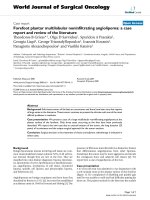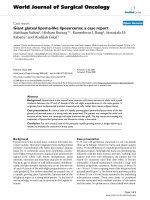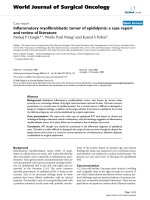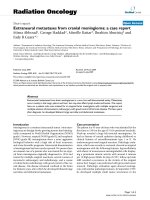Báo cáo khoa hoc:" Chylous ascites following radical nephrectomy: a case report" ppsx
Bạn đang xem bản rút gọn của tài liệu. Xem và tải ngay bản đầy đủ của tài liệu tại đây (297.63 KB, 5 trang )
BioMed Central
Page 1 of 5
(page number not for citation purposes)
Journal of Medical Case Reports
Open Access
Case report
Chylous ascites following radical nephrectomy: a case report
Shahzad S Shah, Kamran Ahmed, Richard Smith, Ravi Mallina,
Pouya Akhbari and Mohammad S Khan*
Address: Department of Urology, Guy's Hospital, Guy's & St Thomas' NHS Foundation Trust & GKT School of Medicine, London SE1 9RT, UK
Email: Shahzad S Shah - ; Kamran Ahmed - ; Richard Smith - ;
Ravi Mallina - ; Pouya Akhbari - ; Mohammad S Khan* -
* Corresponding author
Abstract
Introduction: Chylous ascites may result from diverse pathologies. Ascites results either due to
blockage of the lymphatics or leak secondary to inadvertent trauma during surgery.
Case presentation: We report the first case of chylous ascites following radical nephrectomy for
a renal cell carcinoma involving the right half of a crossed fused renal ectopia. The patient was
managed conservatively.
Conclusion: Post-operative chylous ascites is a rare complication of retroperitoneal and
mediastinal surgery. Most cases resolve with conservative treatment which aims at decreasing
lymph production and optimizing nutritional requirements along with palliative measures.
Refractory cases need either open or laparoscopic ligation of the leaking lymphatic channels. A
review of the current literature on the management of post-operative chylous ascites is presented.
Introduction
Chylous ascites results from either blockage of the lym-
phatics or leakage secondary to inadvertent trauma during
surgery. Most cases of traumatic chylous ascites resolve
with conservative treatment but refractory cases may need
surgical ligation of lymphatics. We report the first
reported case of chylous ascites following radical nephrec-
tomy for a renal cell carcinoma involving the right half of
a crossed fused renal ectopia. The chylous ascites resolved
with conservative management. A brief review of the liter-
ature on the management of post-operative chylous
ascites is presented.
Case presentation
A 60-year old male presented with acute right loin pain
and frank haematuria. He was hypertensive but well con-
trolled on medication. He had undergone coronary artery
bypass grafting 9 years earlier. Physical examination was
normal apart from a median sternotomy scar. Urine was
sterile on culture and showed no malignant cells on cytol-
ogy. Urea, creatinine and electrolytes were within normal
range. Ultrasound scan showed no kidney in the left renal
area and a 7 × 5 × 5 cm heterogenous irregular mass aris-
ing from the mid-pole of the right kidney. CT scan con-
firmed the presence of a large complex mass measuring
11.6 × 8 × 6.5 cm arising from the mid and upper pole of
the right kidney. In addition it showed a cross fused left
kidney in the right iliac fossa (Fig. 1). There was a single
aorto-caval lymph node measuring 8 mm but no pulmo-
nary metastases.
An open right radical nephrectomy was performed. The
dissection of the kidney was straightforward. The isthmus
between the right and left kidney was transected without
Published: 11 January 2008
Journal of Medical Case Reports 2008, 2:3 doi:10.1186/1752-1947-2-3
Received: 23 February 2007
Accepted: 11 January 2008
This article is available from: />© 2008 Shah et al; licensee BioMed Central Ltd.
This is an Open Access article distributed under the terms of the Creative Commons Attribution License ( />),
which permits unrestricted use, distribution, and reproduction in any medium, provided the original work is properly cited.
Journal of Medical Case Reports 2008, 2:3 />Page 2 of 5
(page number not for citation purposes)
any complications and the raw surface of the left kidney
over-sewn with surgical bolsters. A para-aortic lymph
node dissection was undertaken between the superior
mesenteric artery and bifurcation of the aorta. The surgical
procedure did not differ from a standard radical nephrec-
tomy except for the division of the isthmus. On histology,
the tumour was a classical clear cell adeno-carcinoma with
no nodal metastases (pT2N0).
Post-operatively the patient had copious (150–200 mls
daily) drainage via a retroperitoneal drain which on bio-
chemical analysis was consistent with serum. Hence the
drain was removed. The patient was discharged on day 5
but was readmitted three weeks later with abdominal dis-
tension and pain. Clinically he had ascites. This was con-
firmed on CT scan (Fig. 2). Paracentesis and biochemical
analysis were consistent with chylous ascites.
The patient was initially managed with oral diuretics
(Furosemide 40 mg twice daily & Spironolactone 25 mg 8
hourly). Treatment resulted in hyponatraemia and hypo-
tension without any improvement in ascites and hence
was discontinued. A therapeutic paracentesis was per-
formed to alleviate abdominal discomfort. The patient
was then commenced on parenteral nutrition and
medium chain triglycerides. This resulted in gradual reso-
lution of ascites and no reaccumulation during two
months of follow up (Fig. 3).
Discussion
Chylous ascites is a rare condition. Its etiological factors
can be broadly classified as congenital, infective, neoplas-
tic and traumatic or post surgical. The majority of cases are
caused by diseases that interfere with abdominal or retro-
peritoneal lymphatic drainage. Amongst surgical proce-
dures, vascular operations account for the majority of
post-operative chylous ascites [1]. This complication may
become evident within a few days following surgery or
take several months [2].
The lymphatic drainage from the kidney and testes is to
the retroperitoneal para-aortic nodes. Thus chylous ascites
is a well recognized complication of retroperitoneal node
Resolution of ascites following conservative treatmentFigure 3
Resolution of ascites following conservative treatment.
CT scan showing tumour in the upper moiety of the crossed fused renal ectopiaFigure 1
CT scan showing tumour in the upper moiety of the crossed
fused renal ectopia.
Post-operative chylous ascitesFigure 2
Post-operative chylous ascites.
Journal of Medical Case Reports 2008, 2:3 />Page 3 of 5
(page number not for citation purposes)
dissection (RPLND) for testicular cancer. However, only
34 cases of chylous ascites have been reported in the Eng-
lish medical literature following renal surgery for diverse
indications. These included twelve (n = 12) after radical
nephrectomy for Wilm's tumour, nine (n = 9) for renal
cell carcinoma, eight (n = 8) after laparoscopic donor
nephrectomy, two (n = 2) following nephro-ureterectomy
and one each for renal abscess, renal trauma and non-
functioning kidney.
Presentation of post-operative chylous ascites is similar to
ascites due to other causes including progressive abdomi-
nal distention and weight gain. The patient may complain
of dyspnoea due to reduced diaphragmatic movements or
chylothorax. Non-specific symptoms include nausea,
vomiting or post operative wound leakage. The diagnosis
can be confirmed by abdominal paracentesis. The aspirate
is typically milky white and stains positive for fat with
Sudan III. Its specific gravity is greater than 1.012 and has
alkaline pH. Cytology shows predominantly lym-
phocytes. Chemical analysis reveals high triglyceride lev-
els 2–8 fold that of plasma (range 0.4–4 gm/dl) and
protein content greater than 3 gm/dl. Serum abnormali-
ties include hypoalbuminaemia, lymphocytopenia and
anemia secondary to protein loss and malnutrition. Occa-
sionally the diagnosis is evident only on exploration.
Bipedal lymphangiography with ethiodized oil injected
into lymphatic vessels on the dorsum of the foot has been
the traditional way of mapping the lymphatic tree. Lym-
phangiography however, is technically challenging, time
consuming and has the additional disadvantage of stain-
ing the operative field. Therefore lymphangiography has
been abandoned in favour of newer radiological tech-
niques [3].
Pui and Yueh report their experience with
99m
technetium
(Tc)-antimony sulfide colloid, human albumin or dex-
tran-scintigraphy for chylous collections. They claim that
lymphoscintigraphy can accurately pin point lymphatic
leaks and thus may be a useful tool in selecting patients
for surgery [4].
CT scan remains the imaging of choice. It may point to the
diagnosis by demonstrating simultaneous intraperitoneal
and extraperitoneal fluid collections following retroperi-
toneal nephrectomy. As the density of the chylous fluid is
identical to water, it is indistinguishable from clear
ascites, urine or bowel fluid but the pathognomonic fea-
ture of chylous ascites on CT scan is," fat fluid level",
which may be demonstrable, if the patient is imaged after
a prolonged period of lying supine [5].
The treatment for chylous ascites is aimed at alleviation of
the discomfort associated with the distended abdomen,
reducing the flow of lymph to the mesenteric lymph
nodes, which join together to form the retroperitoneal
lymph channels, and replacement of the nutritional
losses.
These objectives are achieved through therapeutic para-
centesis, when required, in combination with diuretics
and restricted salt intake, a high protein, low fat, medium
chain triglyceride diet, and parenteral nutrition [3]. Soma-
tostatin has recently been shown to be effective in the
treatment of this condition [6].
Paracentesis may be performed early both as a diagnostic
tool and as a palliative measure. Its main advantage is its
immediate palliation but paracentesis is not effective on
its own unless combined with other conservative meas-
ures. Repeated drainage of the ascitic fluid may prolong
the leak, depress immunity and increase nutritional
requirements [2].
Dietary intervention remains the mainstay of conservative
treatment of chylous ascites and consists of a high protein,
low fat, medium chain triglyceride diet. The rationale for
using medium chain triglycerides is the fact that these
bypass the lymphatic channels of the gut and enter
directly into the portal venous system in contrast to long
chain triglycerides which enter the portal venous blood
through the lymphatics of the bowel. It has been recom-
mended that medium chain triglycerides should be con-
tinued for several months after resolution of the ascites
[3].
Total parenteral nutrition is an essential component in the
management of chylous ascites and serves two important
objectives. It fulfills the nutritional requirement of these
patients, most of whom are malnourished due to their
inability to tolerate oral feeding. More importantly it
helps to decrease the production of lymph and allows the
bowel to rest. The resolution of chylous ascites is reported
to occur within 2–6 weeks in 60–100% patients with TPN
alone, or in combination with medium chain triglycerides
and paracentesis [7]. Although not all patients respond to
TPN alone this should be part of any conservative treat-
ment plan.
Somatostatin is a naturally occurring peptide consisting of
14 to 28 amino acids. It is found in the central nervous
system, gastrointestinal tract and the pancreas. It decreases
the intestinal absorption of fats, lowers triglyceride con-
centration in the thoracic duct and attenuates the lymph
flow in the major lymph vessels. It also decreases splanch-
nic blood flow. Analogues now available are octreotide
and lanreotide which are octapeptides with a much longer
half life than somatostatin. Since somatostatin interferes
Journal of Medical Case Reports 2008, 2:3 />Page 4 of 5
(page number not for citation purposes)
with blood glucose regulation, close monitoring of blood
glucose is recommended during its administration [8].
Other therapeutic measures include intravenous etile-
frine, a sympathomimetic drug which acts by contracting
the smooth muscle of the thoracic duct thereby decreasing
the flow of chyle.
Surgical intervention is needed if the lymphatic leak per-
sists in spite of maximal conservative therapy for several
weeks. This usually entails either direct suture ligation of
the disrupted lymphatic channels or insertion of a perito-
neovenous shunt [1].
If surgical intervention becomes mandatory, in some
cases the site of the fistula may be visible. Identification of
the fistula may be helped by a fatty meal taken pre-opera-
tively or by intra-operative injection of a contrast. Suture
ligation of the lymphatics results in termination of the
leak. If a definitive leak site can not be identified, suturing
of the retro-aortic tissues en-mass may resolve the lym-
phatic leak [2]. Better outcomes of surgery are expected in
patients with accurate localization of the leak. The main
disadvantage of surgery is the hazard of re-operating on
already compromised patients who are just recovering
from major surgical trauma. Despite its disadvantages sur-
gical therapy remains an effective option for refractory
cases [9].
There is no consensus as regards the exact timing of oper-
ative intervention but it is generally recommended that
conservative therapy should be tried for at least 4–8 weeks
[1].
Peritoneovenous shunting is an alternative to exploration
in patients with rapid accumulation of ascitic fluid. This
avoids nutritional depletion as the fluid is re-circulated.
Shunts are associated with fewer complications than
repeat paracentesis but complications like disseminated
intravascular coagulation (DIC), fat embolism and fatal
sepsis may occur [3].
Cope describes a technique of catheterization of the
cysterna chyli and major retroperitoneal lymphatic ducts
by percutaneous transabdominal puncture and embolisa-
tion of the leaking lymphatic trunk but the safety of this
technique is yet to be established [10].
The prognosis of patients with chylous ascites depends
upon the condition causing the leak, associated co-mor-
bidities and the pathological condition for which surgery
was performed in the first place. Generally the prognosis
of patients with non-surgical ascites is poorer because of
underlying causes. Post-operative chylous ascites has a
better prognosis. Pabst et al, in a review of 17 published
reports, documented successful resolution of post-opera-
tive chylous ascites in 92.3% of patients, the majority of
patients responding to conservative therapy [2].
Conclusion
Post-operative chylous ascites is a rare complication of ret-
roperitoneal and mediastinal surgery. The condition
poses a difficult management problem. Most cases resolve
with conservative treatment which usually involves a pro-
longed period of multimodal therapy aimed at decreasing
lymph production and optimizing nutritional require-
ments along with other palliative measures. Refractory
cases may need either open or laparoscopic ligation of the
leaking lymphatic channels.
Competing interests
The author(s) declare that they have no competing inter-
ests.
Authors' contributions
All authors have read and approved the final manuscript.
SSS acquired patient records, data and drafted the manu-
script.
KA participated in acquisition of data.
RS participated in acquisition of data.
RM participated in acquisition of data.
PA participated in acquisition of data.
MSK carried out the design of the study, coordinated the
study, drafted the manuscript and obtained consent from
the patient.
Consent
"Written informed consent was obtained from the patient
for publication of this case report and any accompanying
images. A copy of the written consent is available for
review by the Editor-in-Chief of this journal."
References
1. Combe J, Buniet JM, Douge C, Bernard Y, Camelot G: Chylothorax
and chylous ascites following surgery of an inflammatory
aortic aneurysm. Case report with review of the literature. J
Mal Vasc 1992, 17(2):151-156.
2. Pabst TS 3rd, McIntyre KE Jr, Schilling JD, Hunter GC, Bernhard VM:
Management of chyloperitoneum after abdominal aortic
surgery. Am J Surg 1993, 166(2):194-199.
3. Ilan l, Yoram M, Jacob G, Jacob R: The diagnosis and manage-
ment of postoperative chylous ascites. Review article. J Urol
2002, 167:449-457.
4. Pui MH, Yueh TC: Lymphoscintigraphy in chyluria, chyloperi-
toneum and chylothorax. J Nucl Med 1998, 39(7):1292-1296.
5. Wachsberg RH, Cho KC: Chyloperitoneum: CT diagnosis. Clin
Imaging 1994, 18(4):273-274.
Publish with BioMed Central and every
scientist can read your work free of charge
"BioMed Central will be the most significant development for
disseminating the results of biomedical research in our lifetime."
Sir Paul Nurse, Cancer Research UK
Your research papers will be:
available free of charge to the entire biomedical community
peer reviewed and published immediately upon acceptance
cited in PubMed and archived on PubMed Central
yours — you keep the copyright
Submit your manuscript here:
/>BioMedcentral
Journal of Medical Case Reports 2008, 2:3 />Page 5 of 5
(page number not for citation purposes)
6. Ulibarri JI, Sanz Y, Fuentes C, Mancha A, Aramendia M, Sanchez S:
Reduction of lymphorrhagia from ruptured thoracic duct by
somatostatin. Comments. Lancet 336(8709):258. 1990 Jul 28
7. Petrasek AJ, Ameli FM: Conservative management of chylous
ascites complicating aortic surgery: a case report. Can J Surg
1996, 39(6):499-501.
8. Collard JM, Laterre , Boemer F: Conservative treatment of post-
surgical lymphatic leaks with somatostatin-14. Chest 2000,
117:902.
9. Bauwens K, Jacobi CA, Gellert K, Aurisch R, Zieren HU: Diagnosis
and therapy of postoperative chyloperitoneum. Chirurg 1996,
67(6):658-660.
10. Cope C: Diagnosis and treatment of postoperative chyle leak-
age via percutaneous transabdominal catheterization of the
cisterna chyli: a preliminary study. J Vasc Interv Radiol 1998,
9(5):727-734.









